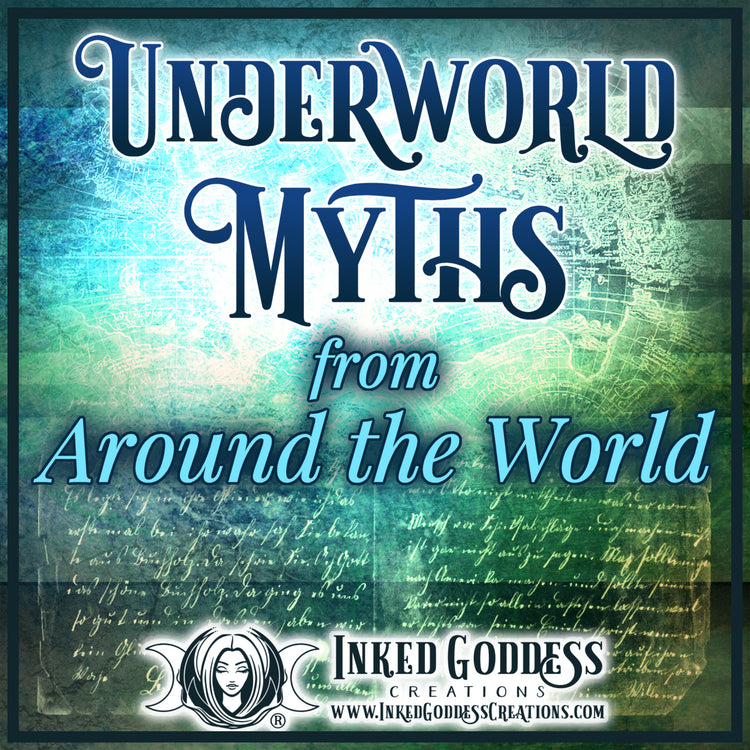Underworld Myths from Around the World

Almost every culture has coped with the mystery and fear of death by telling stories of the afterlife. What sort of gods would rule that land? What determines whether a soul can enter? Is the Underworld a good or bad place?
Many of us are familiar with the Greek underworld, ruled by Hades and populated by the souls of the deceased, as well as the Egyptian afterlife, where Anubis would weigh the heart of the deceased against a feather. Both mythologies are filled with fascinating stories about the transition from life to death, such as Ra’s journey across the sun or Orpheus’s journey to save his wife from death.
But there are other interesting stories about the Underworld, stories about the creation of the afterlife or the fates of unusual souls. As the veil grows thinner and death lingers in the mind, let’s take a deeper look into lesser-known Underworld myths.
Arawn and His Hounds
Arawn is the Celtic god of death, described as a Grim Reaper figure who punishes wrongdoers. Despite this, the Celtic underworld, also considered Arawn’s kingdom, Annwn, is much cheerier and joyful than other Underworlds described later in this list. He is also often associated with abundance and virtue. One of Arawn’s most notable traits is his love for his hounds, who run alongside the Wild Hunt and lure wandering souls with their howls.
One story featuring Arawn sees him punish Pwyll, a mortal king, when Pwyll denies Arawn’s hounds their food so that his own hounds can eat. Other stories suggest that Pwyll was instead punished because one of his hounds killed an underworld stag. Pwyll was forced to switch places for Arawn for a year and a day, with the two magically taking on one another’s forms. Pwyll defeats Hagdan, Arawn’s rival for king of the underworld, and refuses to sleep with Arawn’s wife. At the end of the year and a day, Arawn rewards Pwyll’s honor and virtue by returning him to his true form.
Hel
Hel is both the name of the Norse goddess of death as well as the Norse afterlife. Hel was the child of Loki, along with the massive serpent Jormungandr and the wolf Fenrir, and as a result, wasn’t trusted by the rest of the deities. She was banished to the Underworld as a precaution, where she became an important part of several key Norse myths, like the beginning of Ragnarök and the death of Baldur. While those who died in battle went to Valhalla and those who died at sea went to Aegir’s underwater palace, most people who died more mundane deaths went to Hel.
Despite the fearsome reputation of Hel the place, Hel the goddess was known to be kind and gentle to her subjects. One myth best demonstrates her giving nature.
The death of Baldur is an important part of the Norse mythology, starting the downfall of Loki. Baldur was one of the most beloved members of the pantheon, and his mother, Frigg, was so devasted by his death that she asked for a volunteer to go to the Underworld and appeal to Hel’s pity in hopes of bringing Baldur back to life. Hel agreed on the condition that “all things” cry for Baldur. When a single giantess refuses to mourn, Balder was condemned to stay in Hel until Ragnarök.
Izanagi’s Journey to Yomi
In Japanese folklore, the land of the dead is called Yomi – no – kuni and features prominently in their creation myth, where the gods Izanagi and Izanami give birth to the rest of the deities. Unfortunately, Izanami dies giving birth to Kagautsuchi, the god of fire. After taking his grief out on the child, Izanagi travels to Yomi to see his beloved wife again and bring her back with him to Earth.
After arriving in Yomi, Izanami is delighted to see her husband and tells him that she will ask the god of death if she can leave the Underworld, but asks that Izanagi not look at her until she figures the situation out. Like Orpheus, Izanagi can’t contain himself, and when he looks at his wife, he freaks out at her deathly pallor and ominous presence.
Izanami is understandably upset at his reaction and sends a horde of undead fiends to attack him, chasing Izanagi out of the Underworld. He blocks the entrance, and the two former lovers are separated indefinitely.
Ereshkigal’s Marriage to Nergal
The Mesopotamian afterlife is a surprisingly dismal place, considering it isn’t a place of punishment for bad souls or those who committed sins in life. This may be because, like Hel, the goddess of the Mesopotamian afterlife is a tragic figure. In Ereshkigal’s case, she was the daughter of the supreme god of the Mesopotamian pantheon and only became queen of the Underworld because a dragon kidnapped her and brought her to the underworld. Like many mythologies, one cannot leave the Underworld once one enters, so Ereshkigal was trapped there.
One of the most interesting myths attached to Ereshkigal is the story of her marriage to Nergal, the god of war. After he insults her son, Ereshkigal insists the other gods send Nergal to the Underworld, where she will kill him after he passes through the infamous seven gates. With the help of 14 demons, Nergal defeats Ereshkigal and her son and prepares to decapitate her. Ereshkigal bargains for her life by offering to become his wife. Nergal accepts the offer and remains in the afterlife with Ereshkigal as her husband.
Interestingly, this story has parallels to the story of Persephone and Hades, as Nergal can only remain in the Underworld for half of the year, as war is considered too important for him to stay away.
